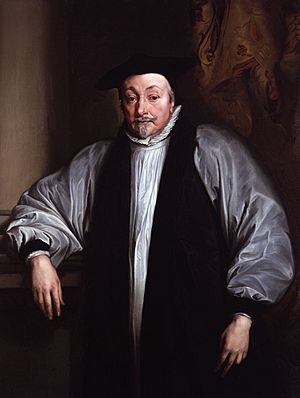Laudianism facts for kids

Laudianism was a special way of thinking and a reform movement within the Church of England in the early 1600s. It was led by Archbishop William Laud and his followers. This movement disagreed with the idea of predestination, which was a main belief of Calvinism at the time. Instead, Laudians believed in free will, meaning people could choose to follow God and find salvation. Laudianism is famous for how it shaped the Anglican high church movement. It put a lot of importance on church ceremonies and the structure of church leaders.
Contents
What Did Laudians Believe?
Before Laudianism, the Church of England had a mix of ideas from Catholic teachings, Calvinism, and some parts of Lutheranism. A key idea in Calvinism was predestination, which meant God had already chosen who would be saved.
Laudianism had different ideas. It focused on God's grace and the belief that all people could be saved if they chose to believe. This meant they rejected the strict ideas of predestination. Instead, they thought God knew who would believe in Him (conditional election).
Laud also wanted everyone to follow the same church rituals. This caused a lot of disagreement, especially with the Puritans, who wanted simpler church services.
How Laudianism Changed the Church
Laudianism caused a big split within English Protestantism. Before, many different Protestant groups felt like they were part of the same family. But Archbishop Laud saw things differently.
He believed that Protestant groups who didn't follow the Church of England's rules, like the Puritans, were a real threat. He felt his own beliefs were closer to the old Roman Catholic Church than to these other Protestant groups.
In 1633, a Latin-English dictionary was updated and dedicated to William Laud. It included a new word, Praedestinatiani. This word described people who believed in a very strict form of predestination, saying that everything, including who was saved or not, was already decided.
King James I started to support church leaders who were against Calvinism. He promoted people like Lancelot Andrewes and George Montaigne. Eventually, he made Laud a bishop. This helped the Laudian movement grow stronger.
King Charles I continued this trend. He promised Laud the top job of Archbishop of Canterbury. Laud then became the main religious voice for the king. As Bishop of London, Laud controlled what was printed. He stopped any discussions about predestination.
In 1628, George Villiers, 1st Duke of Buckingham, became the head of Cambridge University. After this, teaching about predestination was banned there. The king also made a rule that effectively outlawed Calvinism across the country.
Laudianism also changed how churches looked. In 1617, Richard Neile, a supporter of Laud, moved the communion table in Durham Cathedral to the east end, making it look like an altar. Laud supported similar changes in other churches.
In the 1630s, Laud said that the altar was the most important place in a church. He believed it was more important than the pulpit, because the altar was where people received Holy Communion. This practice was similar to Lutheran churches, which kept medieval altars. However, it was different from Calvinist churches, which focused on the pulpit and preaching.
Laudianism and the English Civil War
In the 1630s, people's religious opinions became very divided. This was due to new ideas, events in Scotland, the Thirty Years War, and problems within the church. People who supported Laud were often attacked.
After 1640, Laudians and their supporters faced strong opposition from both the Parliament and the public. In 1640, church leaders passed new rules called the Constitutions and Canons Ecclesiasticall. One rule, known as the "et cetera oath," made priests promise to support the Church of England's structure and bishops.
However, these rules could not be enforced for long. By December 1640, many bishops were accused of wrongdoing. Within a few months, Parliament wanted to get rid of the entire church system and rebuild it in a Puritan way.
Church judges were removed, and the High Commission, which protected the church, was abolished. This left the Church of England unprotected. Prayer books and special robes were torn up. Communion tables were moved, and altar rails were burned. The Laudian version of the Anglican Church would not return until the monarchy was restored in 1660.
See also

